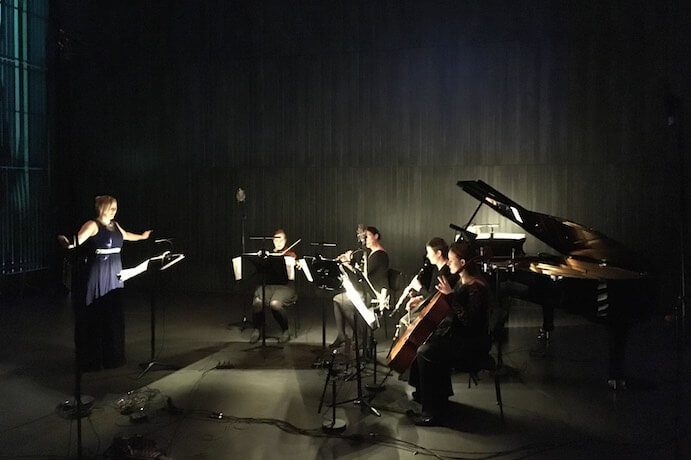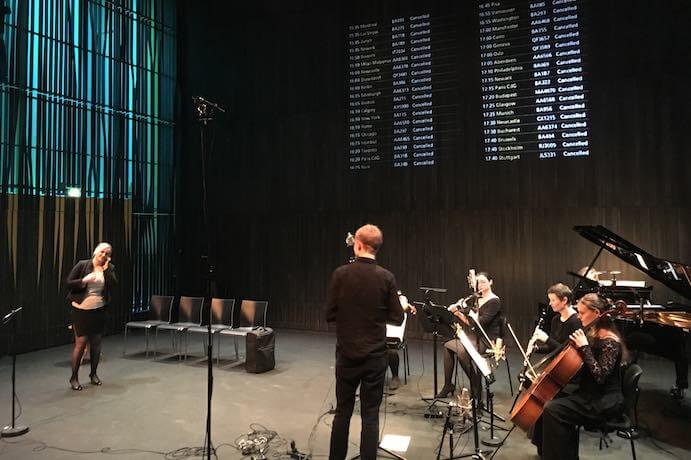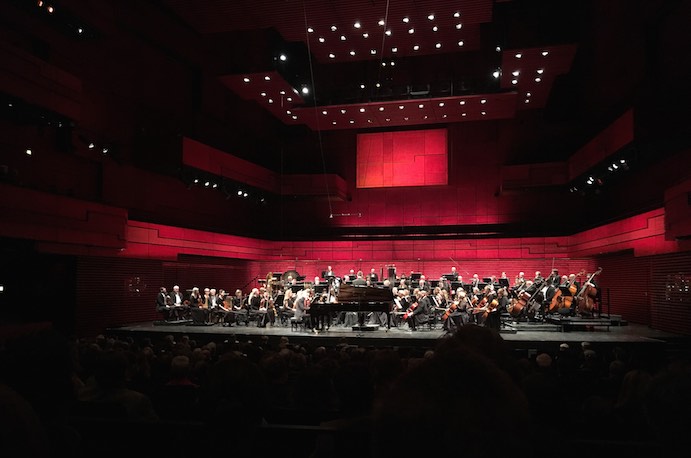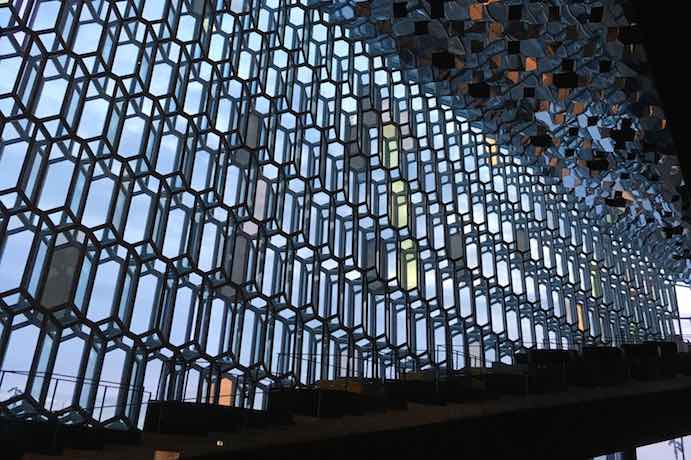The Dark Music Days Festival takes place within Harpa, a 21st century space of giant proportions; a massive, glistening structure of glass and steel which etches itself simultaneously out of the sea and the sky. Inside, its open structure belies a plentitude of state-of-the-art halls and stages, which feature configurable acoustical treatments and serve as dramatic visual grounds against which performances here actualize themselves. In the first day of concerts for this long-running series– known for its new music heritage in Iceland– the exceptional Elektra Ensemble, followed by the Iceland Symphony under Daníel Bjarnason presented chamber music, new instrumental concerti, and large-scale symphonic works.
Commencing in the Kaldalón hall, soprano Elísabet Einarsdóttir and the Elektra Ensemble presented four world premieres of multimedia chamber works by the composers of the Errata Collective. In Halldór Smárason’s piece Vegfarendur og ég, soprano Einarsdóttir conducted col legno cello figurations and prepared piano percussives as she vacillated between bel canto and sprechstimme singing, breathing and blowing into her microphone as a CCTV video feed of a roadway intersection played. Woodwinds predominated as Margrét Árnadóttir’s walking pizzicato bassline on the cello meshed with vocal utterances of vowels and consonants, creating disparate continuities.
Bára Gísladóttir’s piece Nið(ur), based on the poem Haustið Nálgast by Stefán frá Hvítadal, describes an approaching autumn. The strings produced a bed of harmonics upon which Emilía Rós Sigfúsdóttir’s flute and Helga Björg Arnardóttir’s clarinet playing danced about in high registers while pianist Ástríður Alda Sigurðardóttir scraped the strings of the instrument with a metallic spatula. Gísladóttir places particular emphasis on the text as it relates to the ‘dampness’ she locates in nature’s autumnal dying, conjuring through a sparse texture images of “golden” clouds and a mist (dögg: a word for this particular seasonal wetness) which clings to the grass. The players sat together in silence as the piece ended while soprano Einarsdóttir repeated a phrase, capturing the beauty which only death can claim as its own.

Einarsdóttir and Elektra Ensemble–Photo by Gavin Gamboa
In Finnur Karlsson’s Stjórn, Einarsdóttir re-entered the stage in darkness already singing her line, switching on each player’s stand lamp as trills and harmonics flowed from Helga Þóra Arnardóttir’s violin. Flourishes of the overtone series emerged. A noisy rumble of electronics interjected, and Einarsdóttir walked over to touch the speaker which immediately ceased producing its chaotic noise. Beautiful and brief eruptions emanated, accompanying the soprano’s gesturing with her arms to the sky, clapping her hands in the air to cut the flow of Elektra Ensemble’s audibility.
The last work on this intriguing program was Gos by the young Swedish composer Petter Ekman. Einarsdóttir, now formally dressed with a rolling luggage and standing on the other side of the stage amongst several chairs, viewed a video display of a flight timetable with all flights showing CANCELLED. The vocal line jumped between Icelandic and English. The sardonic predicament that the singer finds herself in brought the audience into fits of laughter over the course of the piece. She is a Geology expert on her way to a conference to discuss the Móðuharðindin, a catastrophic eruption of the Laki volcano in 1783, when the more recent eruption of Eyjafjallajökull (2010) disrupts all travel out of Iceland, preventing her from attending her conference. Lamentations of famine are quirkily juxtaposed against apathetic “yeah, yeah” declamations, and Einarsdóttir then sat and read from a book as the Elektra Ensemble continued to produce dizzying plumes of sound. She began tearing out pages and proceeded to eat them. Ekman here is referencing the famine of 1783, when many were reduced to eating manuscripts to survive. The final crescendo– which builds so well into a dramatic pause with all momentum pointing towards our soprano protagonist– is a wonderful ‘gotcha’ moment; as her mouth is filled with paper, she cannot give the final delivery, and the piece ends.

Einarsdóttir and Elektra Ensemble– Photo by Gavin Gamboa
Day One ended in spectacular fashion in the main hall of Harpa, the Eldborg. It is a stunning space that drips with the color red and is replete with right angles. The Iceland Symphony under the baton of Daníel Bjarnason began with its world premiere of Áskell Másson’s flute concerto Gullský (2015). Known for his percussion works, the piece opens rather motionless at first. Flutist Melkorka Ólafsdóttir’s graceful solo figurations floated above harp, strings, gongs, and bass drum. These lush environments of sound supported Ólafsdóttir’s melodious playing, which seemed perfectly suited to Másson’s tendency towards stressing non-scalar passing tones. A final diminuendo into nothingness ends the work, its crisp and fleeting nature having the sensation of a temporal compression. Following was an orchestral piece Strati (1993/1999) by Haukur Tómasson (who earned his Masters at the University of California San Diego). Spectral blooms hybridize into quickly bursting lines that turn into moments that hang forever in suspension. An organic, interweaved lattice is manipulated as different groups within the orchestra are dynamically juxtaposed against one another. Bjarnason did exceedingly well directing these complex syncopations, creating a clear sense of foreground and background.

Iceland Symphony– Photo by Gavin Gamboa
At the heart of the program was Þórður Magnússon’s Piano Concerto for orchestra with electronics, deftly played by soloist Víkingur Heiðar Ólafsson. Existing somewhere between neoclassicism and a new impressionism, the work exhibited masterful thematic development via musical sequences and combinations. Its evolution is worth noting, as it variously transformed from a clarinet quintet, to a piano concerto for the left hand, to a purely symphonic work, and then into its current form. Ending the program was Act (2004), an orchestral work by Norwegian composer Rolf Wallin. Functioning like a turbulent ocean threatening to capsize us, the entire orchestra moved in conjunction with itself like a well-oiled machine, leading into huge spectral builds of overpowering tonalities, and an explosive finale.
The impact of these performances which initiated the 2016 Dark Music Days festival was nothing short of astounding, and the sonic worlds they conjured felt very much attached to the precariousness and volatility inherent in the extremes which the land and the climate here embody– a brilliant opening that afforded a penetrating glimpse into Icelandic and Nordic musical imaginations.





















